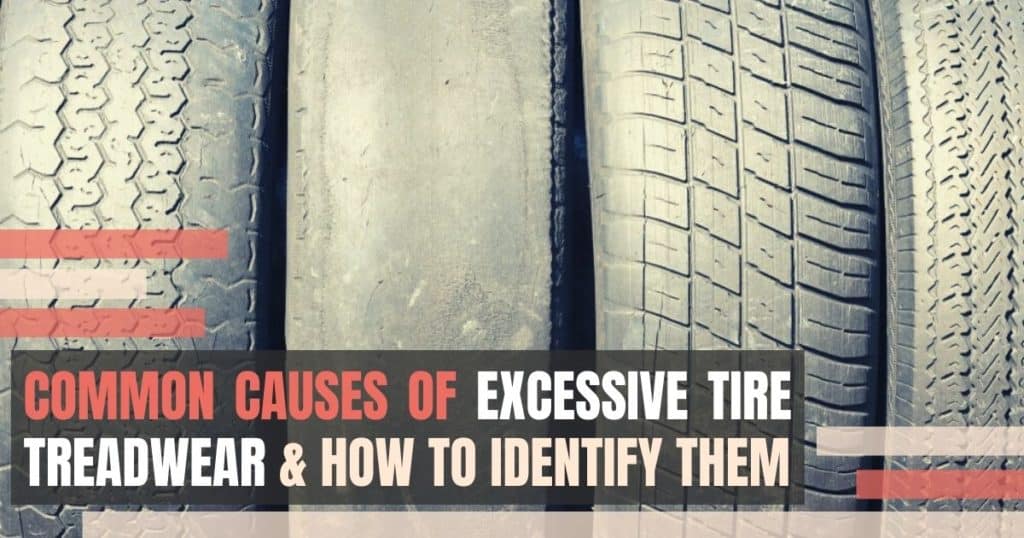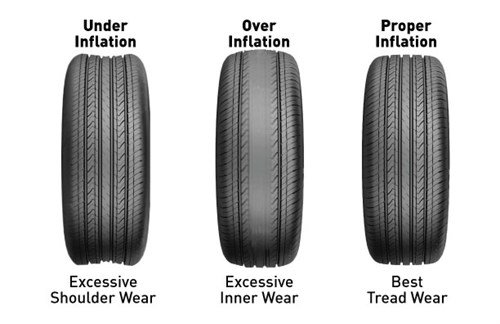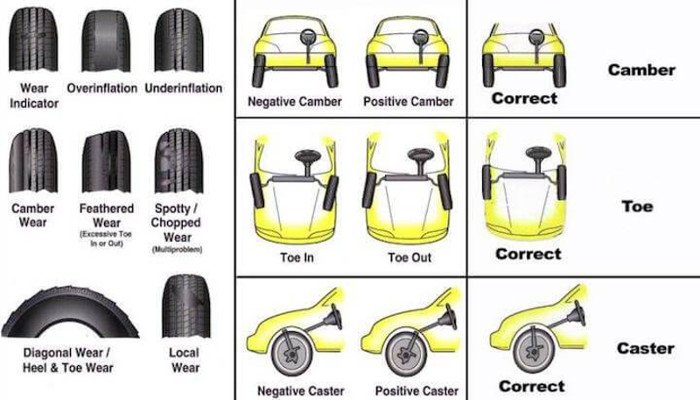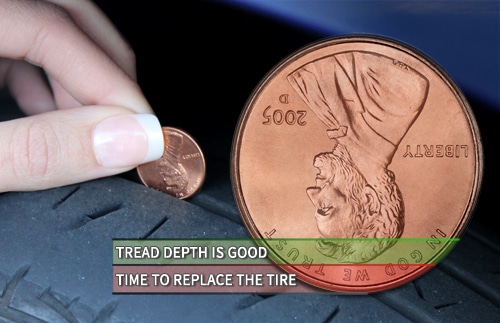Tire tread wear is the slow wearing away of your tire’s tread after contact on the road. Over time, this process is inevitable. However, there are certain factors that can cause your tires to wear faster than they normally should. Below are some strategies to make sure that your tires are not wearing abnormally. This article will help to ensure you prolong the lifespan of your tires.
What are the Most Common Causes of Tire Tread Wear?
The most common (and most normal) cause of tire tread wear is friction with the road. This eventual wearing down of your tires is inevitable, and will happen overtime no matter what you do. The ideal tread wear pattern is an even amount of wear across all four tires, as well as across the surface of each tire.
However, there are certain problems with your tires that can cause them to wear unevenly. The result is that you will need to replace them more often.
Causes of Excessive Tire tread Wear
The most common causes of irregular tread wear are improper alignments, over- and under-inflation of the tires, and problems with the car’s suspension system. You can typically tell the underlying cause of irregular tread wear by noticing which parts of the tire are wearing faster.
Improper Inflation
Improper inflation is one of the most common causes of uneven tire wear and shows up on your tires in easily recognizable patterns.
If you notice excessive wear around the outer edges of your tires, this means that your tires are underinflated. If you notice excessive wear down the center of your tires, this means that your tires are over-inflated. You can typically find the appropriate pressure for your tires posted on a small sticker located inside the doorjamb on the driver’s side of the vehicle. You can also find this information in the owner’s manual. Improper inflation is pretty typical in the second hand tire market.
There is a pressure recommendation embossed on the side of the tires themselves for easy reference while you are adjusting the pressure. In addition to shortening the lives of your tires, improper inflation can have a long-term impact on your car’s fuel efficiency. So ensuring that your tires are properly inflated can save you quite a bit of money, both in tire and gas costs. There are places that you can fill your tires with air for free.
Excessive wear on the inside or outside edge of the tire typically happens when the tires are out of alignment…
Improper Tire Alignment
Uneven tread wear also commonly appears when your tires are misaligned. Tires wear down fastest wherever the tire is carrying the most weight. When tires are properly aligned, the weight should be distributed evenly across the tires. When tires are misaligned, the weight of the car often rests disproportionately on the outer or inner edges of the tire. Because of this, if you see excessive wear on either the outside or the inside edge of the tire (but not both) this often indicates that your tires are misaligned.
If you notice excessive tread wear appearing in diagonal bands across the surface, this can often indicate that parts of your car’s suspension system are worn or bent. A damaged suspension system can cause your tires to become misaligned, but it can also make the car unsafe to drive and cause more extensive damage that requires pricey, labor-intensive repairs.
Feathering
“Tire feathering” is a unique pattern of wear that feels like a rough scuffing when you touch it. This kind of tread wear usually appears when the tires are out of alignment, and can sometimes indicate problems with the car’s suspension.
Cupping
“Cupping” tread wear appears on your tires as a diagonal pattern of excessively worn patches across the surface of your tires. This pattern can often indicate problems with your car’s suspension, and so if you notice this pattern of tread wear, you should speak to a mechanic right away. However, if the irregular tread wear pattern looks more like big patches, rather than diagonal stripes, this often means that the tires are out of balance.
Improper Ride Height
Improper ride height can also throw your tires out of alignment. Therefore, cause your tires to wear unevenly. Ride height is the distance between the frame of your car and the road. If your car is sitting significantly higher or lower than the factory specifications, it can become almost impossible for a mechanic to determine the proper angles for an alignment.
Minimum Safe Tread Depth
The reason tire wear is such a problem is that, once your tread has worn down beyond a certain point, the tires are no longer safe to drive on. The commonly accepted minimum safe tread depth for summer tires is 3 millimeters. Since winter driving conditions are more dangerous, the minimum safe tread depth for winter tires is 4 millimeters.
It can be difficult to get a ruler or measuring tape into your tire’s tread, but a common way to test tread depth is with a penny. Simply insert the penny, head down, into the grooves of your tire’s tread. If you can still see the top of Lincoln’s head, it’s probably time to get new tires. For those of you living and/or driving in the European Union, you can make the same test with a 1 Euro coin. If the gold border of the coin shows above the tire’s tread, it’s time to replace your tires.
Tread Wear Graded Tires
Some tires come with tread wear grades on them, which you can reference. These are an indication of a tire’s relative wear rate. The higher the number, the longer it should take for the tread to wear down. You can reference this grade and see more closely how your tire is performing.
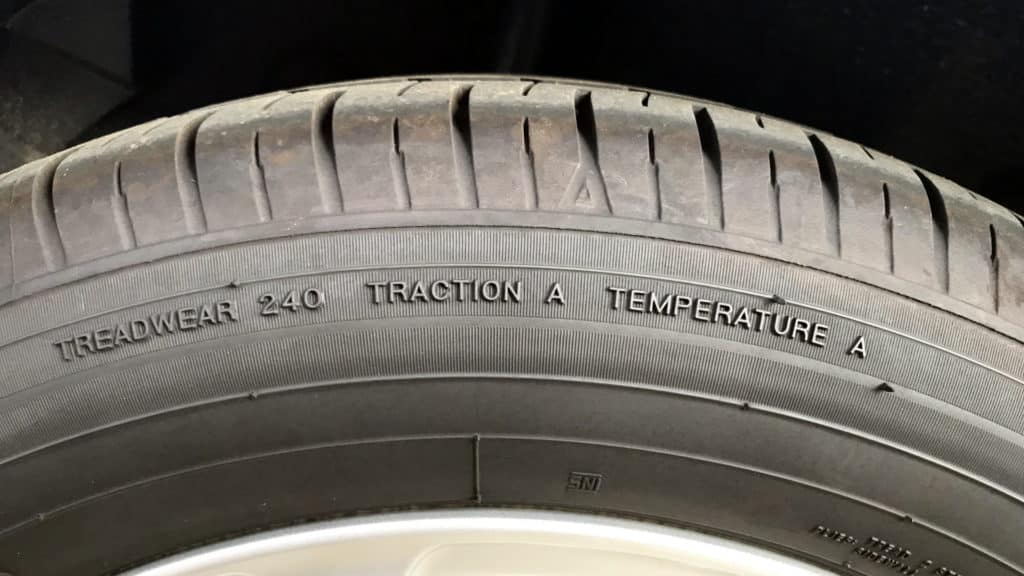
UTQG Rating on a Japanese Tire
The tread wear grade is a government required metric that denotes how quickly a tire will wear. For example a grade of 300 means the tire will wear down 3x slower then a tire graded 100. So the higher the number the better, The trouble though with tread wear grades is they are assigned by the manufacturers and not an independent 3rd party. For more info, read this article: The Truth About Treadwear.
The Dangers of Driving With Excessive or Uneven Tread Wear
Tires are the most important safety feature on a vehicle. They are your only contact point with the ground. You must be able to trust a tires ability to grip the road and provide you traction. The tires tread serves the purpose of giving grip and displacing water so the tire can grip on a wet road.
When the tread wears unevenly or exssively it:
- Shortens the lifespan of the tire.
- Reduces the fuel economy of the vehicle.
- Risks blowouts or air leaks in the excessively worn out areas.
- Reduces the vehicles ability to handle in wet conditions like snow or ice.
What to Do If You Have Tread Wear Issues
In most cases depending on your situation, proper inflation can solve the issues. You hsould also consider finding a shop to assess if you need a suspension alignment. Its important to inspect your tires frequently and learn how identify common issues. Once you diagnose the kind of tread wear you are experiencing you can adjust your inflation or driving style accordingly. Additionally you may need to consider getting an alignment or other basic tire services. In some cases you may also need to consider replacing them.
